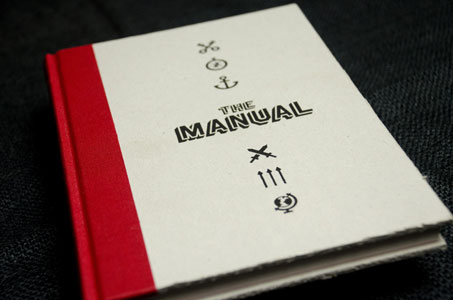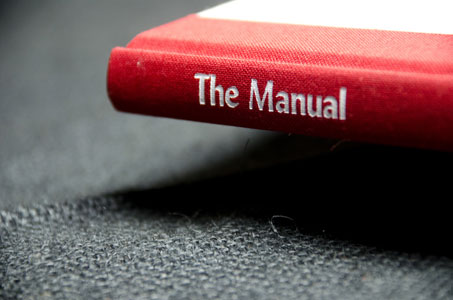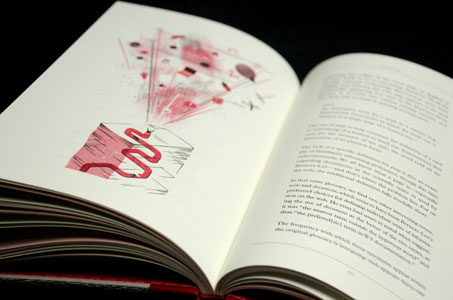After getting our copy of The Manual (@themanual) Giovanni and tore into it and found that it was a quick read with some very interesting stories. A short summary of what Andy very eloquently lays out in his opening letter; Our industry of web design is maturing, we need people to think deeply about it and write about their experience practicing it. I for one welcome this and whole heartedly suggest you read this when you can get your hands on one.
Below and in the above audio is our review and quick discussion of The Manual:
Gene Crawford: OK. We’re here to talk about “The Manual.”
Giovanni DiFeterici: That we are.
Gene: It’s put out by Fiction, which I think is a new design book thing. Andy McMillan I think is the mad-genius behind “The Manual,” but it’s got stories from Simon Collison, Frank Chimero, John Tan, Dan Rubin, Liz Danzico and The Standardistas.
Giovanni: It’s pretty interesting. It’s a quick read. I got through it in about an hour.
Gene: Yeah, I read it in 45 minutes.
Giovanni: OK, well, you win. [laughter]
Gene: Well, what did you think of it?
Giovanni: I thought it was all right. It’s not a book about how to do stuff. It’s really a book about thoughts. To me it’s an attempt to make literature out of web design. Because our industry is so young, we’re missing a lot of things. We’re missing a lot of good research. We’re missing a lot of philosophy about design.
Gene: That’s what I like most about it, that it was just philosophy or pontification loosely tied to the web design industry. I think this is a good thing for our industry for people to be publishing works like this.
Giovanni: I think so, too. I do.
Gene: It means we’re getting mature.
Giovanni: Well, I think it’s an attempt to be mature about it. You know what I mean?
Gene: Yeah.
Giovanni: You have to do that first. I read through it pretty fast. It’s kind of interesting. It’s basically a bunch of essays where there’s a little journaling and fiction woven into it. A lot of it is really romanticized. It’s stories.
Gene: Some more than others.
Giovanni: A lot of the stories are things that did or supposedly happened in the person’s life and they use that to illustrate some philosophical point about web design. I thought it was pretty interesting. Collison, he was a little more directly talking about learning.
Gene: Yeah, he was talking about art school.
Giovanni: A lot of the stories, they were directly related to understanding the things that you do, as opposed to specifically intuition or something like that.
Gene: We’ll skip around I guess. John Tan, his chapter… I guess you call them chapters. His story, “Taxidermista,” was talking about galleries a little bit.
Giovanni: Yeah, that was interesting.
Gene: So I thought it was kind of interesting. It made my ears perk up a little bit. What was your take on that?
Giovanni: Well, you probably should read it if you’re a designer because it’s interesting. He talks a lot about the idea of a gallery and whether or not it actually has value, because it’s not really a fair assessment of a design. Honestly, he has some valid points. If you take a snapshot of a design that is dynamic and changing and interactive and it’s just an image without some curation and direct commentary about it, you basically have no context, so you can’t really judge a design’s success just by how pretty it is. But some galleries do more than that. The way that he talked about it… He talked about the CSS Zen garden. [crosstalk]
Gene: A little before your time.
Giovanni: It’s a little before my time. [laughter]
Gene: I happen to agree with him a lot. I mean that’s something we try to do, when we have the time, is to do the screen casts of the sites here. It’s still not the same environment, but it’s at least an attempt to show the website in its interactive glory as much as possible.
Giovanni: That’s true and we definitely try…
Gene: But how the hell do you preserve a website for all time, without downloading it or stealing it or whatever?
Giovanni: I think that is a difficult thing to do, but he’s probably right. In the end, galleries really need to be a repository for complete sites that you can actually interact with. It will be interesting to do that, but there is the technical difficulty of actually accomplishing that feat. So I think, for now, having static images or video of the site and then actual documentation of the kinds of interactions that are there, basically critiquing it like we do, I think is a good stop gap measure for a while. Another comment on that is that I do think that there is value in just seeing the images, having a wall of stuff.
Gene: Yeah, well, at least you’ve got the initial thing for all time. I mean you can go back on UnmatchedStyle to 2006 or something, which is crazy.
Giovanni: Well, there’s the value of posterity, but I just mean that you can definitely see trends. You can definitely see the surface aesthetic treatments of things. Having a record of that and just having a place to go and see those things is great. So I do think that there is value just inherent in that.
Gene: We won’t go through every chapter, but that’s the value in this book, I think. Whether you accept the terms of how it’s written or not, I think it’s generally good for somebody to be standing back and thinking about these things and writing it down.
Giovanni: I do, too. Don’t get me wrong. Any book like this in any industry in any academic setting is somewhat decadent.
Gene: Well, right.
Giovanni: It’s a thing that, like you said, it’s a group of people pontificating about whatever. It’s definitely not research driven or anything like that. But having a philosophy of design is an important thing. I’ll never argue that that’s not important.
Gene: Then each chapter has a lesson, one or two pages, I don’t know, 800 words or something like that. A lesson section. That was actually my favorite part of the whole… If there’s any little part of the whole sum, that’d be it.
Giovanni: Yeah, I think that the lessons were definitely, the “lessons” were probably the most interesting, in that they were basically very, very short stories that had some sort of lesson built into them. Like John Tan, the story about him being in Thailand.
Giovanni: And Dan Rubin’s barber shop quartet thingy. That was really cool.
Gene: That was a little weird, yeah. I never knew that.
Giovanni: They’re quirky and you definitely get a little insight into the person who is giving their philosophy, which is valuable, but they’re just entertaining, too. In terms of reading through the book, that’s probably the most entertaining part.
Gene: It will be a nice book to have on your shelf because it’s really pretty, the design of it. It looks really good.
Giovanni: It’s definitely made by designers for designers.
Gene: Yeah, it’s awesome. Anyway, that’s “The Manual.” I’m looking forward to seeing what this turns into five issues from now.
Giovanni: Yeah, that’s what I want to see. I’d like to see how it evolves and what kind of tone they hope to set in the future.








0 Comments